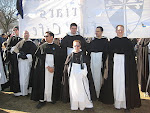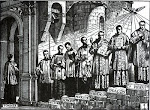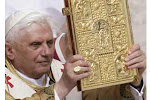
 This chapel, dedicated to St James, but commonly known as
Longworth Chapel, was built in the late 1300’s and was used only for Catholic
worship over 600 years. This also may mean the family in the Old Longworth Manor
House (at the meeting of the rivers Frome and Lugg-not far away, continued to practise their religion
throughout penal times. So this ,like Holywell in North Wales is one of the few
chapels which never lost their Catholic identity, throughout the centuries.At
some time in the 17th century, however, it was replaced by the
present Longworth Hall and built on higher ground. During the time of the
recusancy-possibly-it suffered much, as it was dangerous to allow the
authorities to find a Catholic chapel, so it was as in so many other cases, it
was disguised and used as a barn, the gentry no doubt outwardly conforming to
the new faith, whilse secretly practising their own. However, the severity of
the laws at last broke through and forced the family into conformity, since no
Catholic could own property, and many recusants were impoverished and forced to
flee the country. No doubt some family member was more pragmatic. Emancipation
did not come until the mid nineteenth century.
This chapel, dedicated to St James, but commonly known as
Longworth Chapel, was built in the late 1300’s and was used only for Catholic
worship over 600 years. This also may mean the family in the Old Longworth Manor
House (at the meeting of the rivers Frome and Lugg-not far away, continued to practise their religion
throughout penal times. So this ,like Holywell in North Wales is one of the few
chapels which never lost their Catholic identity, throughout the centuries.At
some time in the 17th century, however, it was replaced by the
present Longworth Hall and built on higher ground. During the time of the
recusancy-possibly-it suffered much, as it was dangerous to allow the
authorities to find a Catholic chapel, so it was as in so many other cases, it
was disguised and used as a barn, the gentry no doubt outwardly conforming to
the new faith, whilse secretly practising their own. However, the severity of
the laws at last broke through and forced the family into conformity, since no
Catholic could own property, and many recusants were impoverished and forced to
flee the country. No doubt some family member was more pragmatic. Emancipation
did not come until the mid nineteenth century.
In any case in 1832 with the Roman Catholic Relief Act ,
Catholics were at last allowed to openly practise their faith. The Oxford
Movement gave great respectability to the faith and many finally could come out
and join the church. One such was a Mr Robert Biddulph Philipps, who owned the
estate. In 1851, when the Hierarchy was being re-established, and religious orders were
being invited in to help set it up. Robert began the refurbishment of the
chapel on its original site (where it had remained). His aim was to provide a
place of worship for his wife and family who had followed him into the church,
and to provide a grave chapel for them. Mass was publically celebrated again
150 years ago on 11th September 1859.
No doubt local Catholics also used it, since very few Mass centres existed when every thing was set up again. Nicholas’ daughter had joined a religious order in France, the Sisters of Our Lady of Charity of Refuge at Caen. It seems he then suffered a cruel blow, when his daughter of 21 suddenly died. He now had no heir, and since he wanted to give his goods to the church, he decided to build and provide for a Convent nearby for the French Order of his daughter, but the nuns wanted higher ground (the chapel stood on the original flood plain).Robert had wanted the Chapel to be associated with the Convent and provided for it to be moved next to the Convent, and desired to be buried in it, but died before anything could be done. Indeed at the cost of £547 the Chapel was taken down and rebuilt next to the convent. The Chapel was perhaps fortunate that the Convent was designed and built 1862-4 by E W Pugin.In 1863, Elizabeth Biddulph (sister Mary of St Peter) arrived from France to take up residence.
No doubt local Catholics also used it, since very few Mass centres existed when every thing was set up again. Nicholas’ daughter had joined a religious order in France, the Sisters of Our Lady of Charity of Refuge at Caen. It seems he then suffered a cruel blow, when his daughter of 21 suddenly died. He now had no heir, and since he wanted to give his goods to the church, he decided to build and provide for a Convent nearby for the French Order of his daughter, but the nuns wanted higher ground (the chapel stood on the original flood plain).Robert had wanted the Chapel to be associated with the Convent and provided for it to be moved next to the Convent, and desired to be buried in it, but died before anything could be done. Indeed at the cost of £547 the Chapel was taken down and rebuilt next to the convent. The Chapel was perhaps fortunate that the Convent was designed and built 1862-4 by E W Pugin.In 1863, Elizabeth Biddulph (sister Mary of St Peter) arrived from France to take up residence.
The chapel is mediaeval in style, but blended with Pugin’s
work, very sensitively. The earthly bodies of Robert Philipps, his wife and
youngest daughter were removed from where they had originally been buried and
brought to lie in the chapel, where they rest.
The Convent remained for 130 years and their mission was as
a refuge for young girls, who were deprived, physically, socially and
spiritually. Sadly in 1993 the sisters had to sell . They had wanted to found a
care village, but all sorts of problems prevented this. Sunday Mass continued
to be offered and the St Richard’s Hospice also continued. Both St Anne’s
Convent Chapel and St James had to be
closed in 1995 and the convent sold for development into luxury flats. In 1997,
the diocese wanted to sell the chapel for development for a nominal sum, but
this was not acceptable to the local congregation and the Charity Commission
and the Historic Chapels Trust became involved. It became a Grade II listed building
and it was recognised as a building of importance both on historical and on
Religious grounds.
Unfortunately, there was vandalism and arson in the chapel
and a great deal of damage was done, and a great deal of money needs to be
found to restore it.December 2002 for example it was set on fire and the fire
brigade were called. Half the floor was burnt out . An inner wall was built,
separating the St Ann’s Convent from the
Chapel, which has survived and is in urgent need of funds.
The Historic Chapels
Trust, and English Heritage Grant and Severn Waste Grant, it can now be
opened now and again, although much more work needs to be done, dealing with
the nsmoke damage, badly damaged altar and reredos, work on the stained glass
windows. Hopefully the people who visit and those who come to the masses will
be able to eventually enjoy the vision of Pugin and the beauty of the Mediaeval
Chapel. It is closely connected with the Hospice-many come here to pray and
grieve, and will provide a quiet and peaceful place for the residents living
locally.
Any donation towards the cost of the restoration of the
chapel will be gratefully received.
OS Grid Reference:
SO5684540595
Location:Longworth Chapel: 41 Frome Park, Bartestree, County of
Herefordshire HR1 4DX
Visit http://www.facebook.com/#!/groups/6377571597/ if you have a Facebook account for more Mary in Monmouth.




















































































